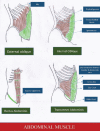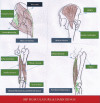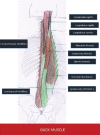Anatomical Correlation of Core Muscle Activation in Different Yogic Postures
- PMID: 28546675
- PMCID: PMC5433114
- DOI: 10.4103/0973-6131.205515
Anatomical Correlation of Core Muscle Activation in Different Yogic Postures
Abstract
Faulty postures due to sedentary lifestyle cause weakening of core muscles which contributes to increased incidence of musculoskeletal disorders (MSDs). Although a few research studies have quantified the core muscle activity in various yogic exercises used in rehabilitation programs, evidence correlating it to functional anatomy is scarce. Such information is important for exercise prescription when formulating treatment plans for MSDs. Therefore, the objective of this review article is to examine the literature and analyze the muscle activity produced across various yoga postures to determine which type of yoga posture elicits the highest activation for the core muscle in individuals. Literature search was performed using the following electronic databases: Cochrane Library, NCBI, PubMed, Google Scholar, EMBASE, and web of science. The search terms contained: Core muscle activation and yogic posture OR yoga and rehabilitation OR intervention AND Electromyography. Activation of specific core muscle involved asanas which depended on trunk and pelvic movements. Description of specific yogic exercise as they relate to core muscles activation is described. This information should help in planning yogic exercises that challenge the muscle groups without causing loads that may be detrimental to recovery and pain-free movement. Knowledge of activation of muscles in various yogic postures can assist health-care practitioners to make appropriate decisions for the designing of safe and effective evidence-based yoga intervention for MSDs.
Keywords: Core muscle activation; musculoskeletal disorders; yoga posture.
Conflict of interest statement
There are no conflicts of interest.
Figures
Similar articles
-
Scapular Muscle Activity During Static Yoga Postures.J Orthop Sports Phys Ther. 2018 Jun;48(6):504-509. doi: 10.2519/jospt.2018.7311. Epub 2018 Apr 6. J Orthop Sports Phys Ther. 2018. PMID: 29623751
-
Identifying yoga-based knee strengthening exercises using the knee adduction moment.Clin Biomech (Bristol). 2015 Oct;30(8):820-6. doi: 10.1016/j.clinbiomech.2015.06.007. Epub 2015 Jun 16. Clin Biomech (Bristol). 2015. PMID: 26094136
-
Energy cost and cardiorespiratory changes during the practice of Surya Namaskar.Indian J Physiol Pharmacol. 2004 Apr;48(2):184-90. Indian J Physiol Pharmacol. 2004. PMID: 15521557
-
Strength and Power-Related Measures in Assessing Core Muscle Performance in Sport and Rehabilitation.Front Physiol. 2022 May 2;13:861582. doi: 10.3389/fphys.2022.861582. eCollection 2022. Front Physiol. 2022. PMID: 35586718 Free PMC article. Review.
-
Sudarshan Kriya Yogic breathing in the treatment of stress, anxiety, and depression. Part II--clinical applications and guidelines.J Altern Complement Med. 2005 Aug;11(4):711-7. doi: 10.1089/acm.2005.11.711. J Altern Complement Med. 2005. PMID: 16131297 Review.
Cited by
-
A Case Report on Core Muscles Training for Knee Osteoarthritis Through Core Muscles Activations and Gait Analysis.Cureus. 2023 Jan 18;15(1):e33918. doi: 10.7759/cureus.33918. eCollection 2023 Jan. Cureus. 2023. PMID: 36819380 Free PMC article.
-
Key characteristics of effective yoga interventions for managing osteoarthritis: a systematic review and meta-analysis.Rheumatol Int. 2024 Sep;44(9):1647-1677. doi: 10.1007/s00296-024-05652-y. Epub 2024 Jun 27. Rheumatol Int. 2024. PMID: 38935121 Free PMC article.
-
Core Muscle Activity During Physical Fitness Exercises: A Systematic Review.Int J Environ Res Public Health. 2020 Jun 16;17(12):4306. doi: 10.3390/ijerph17124306. Int J Environ Res Public Health. 2020. PMID: 32560185 Free PMC article.
-
Implication of Asana, Pranayama and Meditation on Telomere Stability.Int J Yoga. 2018 Sep-Dec;11(3):186-193. doi: 10.4103/ijoy.IJOY_51_17. Int J Yoga. 2018. PMID: 30233111 Free PMC article. Review.
-
Assessment of the Speed and Power of Push-Ups Performed on Surfaces with Different Degrees of Instability.Int J Environ Res Public Health. 2022 Oct 22;19(21):13739. doi: 10.3390/ijerph192113739. Int J Environ Res Public Health. 2022. PMID: 36360619 Free PMC article.
References
-
- McGill SM. A revised anatomical model of the abdominal musculature for torso flexion efforts. J Biomech. 1996;29:973–7. - PubMed
-
- Beckman SM, Buchanan TS. Ankle inversion injury and hypermobility: Effect on hip and ankle muscle electromyography onset latency. Arch Phys Med Rehabil. 1995;76:1138–43. - PubMed
-
- Nadler SF, Malanga GA, Feinberg JH, Prybicien M, Stitik TP, DePrince M. Relationship between hip muscle imbalance and occurrence of low back pain in collegiate athletes: A prospective study. Am J Phys Med Rehabil. 2001;80:572–7. - PubMed
-
- Hultman G, Nordin M, Saraste H, Ohlsèn H. Body composition, endurance, strength, cross-sectional area, and density of MM erector spinae in men with and without low back pain. J Spinal Disord. 1993;6:114–23. - PubMed
-
- Hides JA, Richardson CA, Jull GA. Multifidus muscle recovery is not automatic after resolution of acute, first-episode low back pain. Spine (Phila Pa 1976) 1996;21:2763–9. - PubMed
Publication types
LinkOut - more resources
Full Text Sources
Other Literature Sources




